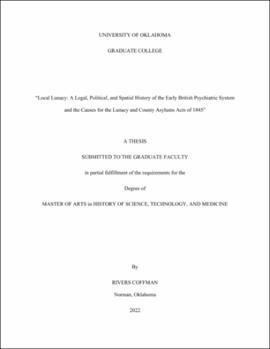| dc.contributor.advisor | Crowther, Kathleen | |
| dc.contributor.author | Coffman, Rivers | |
| dc.date.accessioned | 2022-05-13T18:06:03Z | |
| dc.date.available | 2022-05-13T18:06:03Z | |
| dc.date.issued | 2022-05-14 | |
| dc.identifier.uri | https://hdl.handle.net/11244/335754 | |
| dc.description.abstract | Between 1774 and 1845, British social outlook towards mental health changed drastically and a new wave of prominent medical people revolutionized the field. Quaker beliefs and Enlightenment philosophy influenced ideas of madness, treatment methods used to combat the affliction, and technologies implemented within mental healing spaces. These new techniques and philosophies eventually became the preeminent orthodoxy of the Victorian Age in Britain known as the “non-restraint” movement. These new ideas simultaneously occurred when British society shifted from mental healing in the home and local spaces to specialized institutions designed to care for Britons suffering from mental afflictions. Controversy and scandal followed in its wake, and many Britons petitioned Parliament to create a legal framework for patient protections, mental health institution oversight, and the creation of new institutions to treat pauper patients. Through observation and empirical data, Parliament conducted a three-year inquiry into the full state of insanity in Britain to find a solution to reform the struggling system. Parliament used three institutions and their techniques as a template for the new psychiatric system with standardized treatments and records overseen by the Lunacy Commission, a group of physicians, barristers, and layfolk. The Lunacy Commission and all the standards that Parliament created would coalesce into the Lunacy Act of 1845. However, another problem remained unresolved: the need for more facilities. Through demographic and geospatial analysis of one institution’s admissions, death, and discharge register, this paper reveals that the main causes for County Asylums Act of 1845 were spatial. | en_US |
| dc.language | en_US | en_US |
| dc.rights | Attribution-NonCommercial-ShareAlike 4.0 International | * |
| dc.rights.uri | https://creativecommons.org/licenses/by-nc-sa/4.0/ | * |
| dc.subject | History of British Psychiatry | en_US |
| dc.subject | History of Medicine | en_US |
| dc.subject | Historical GIS | en_US |
| dc.subject | British Mental Health Law | en_US |
| dc.title | Local Lunacy: A Legal, Political, and Spatial History of the Early British Psychiatric System and the Causes for the Lunacy and County Asylums Acts of 1845 | en_US |
| dc.contributor.committeeMember | Hale, Piers | |
| dc.contributor.committeeMember | Loraamm, Rebecca | |
| dc.date.manuscript | 2022-05-06 | |
| dc.thesis.degree | Master of Arts in History of Science, Technology, and Medicine | en_US |
| ou.group | Dodge Family College of Arts and Sciences::Department of History of Science, Technology, and Medicine | en_US |
| shareok.orcid | 0000-0002-9091-8346 | en_US |

